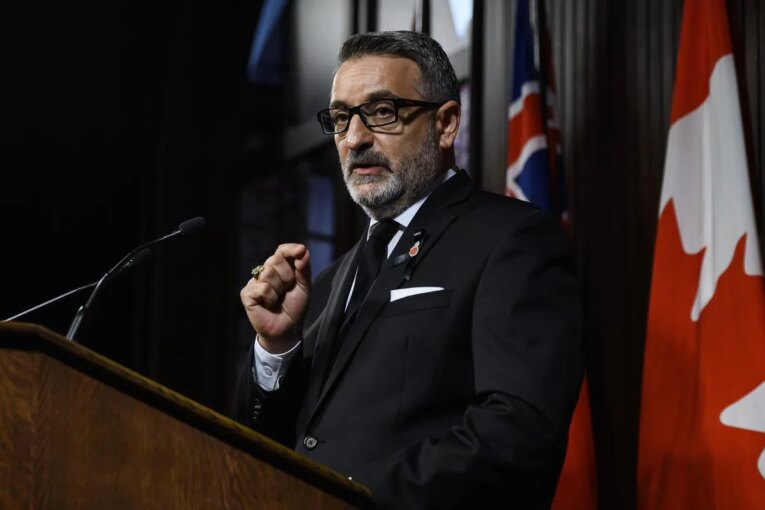
[ad_1]
New national long-term-care standards — highlighting quality of life and safe building design — have received a cool initial reception from the Ontario government.
If the voluntary standards are implemented, funded and enforced, they have the potential to transform the way people live and work in nursing homes, advocates say.
But the degree to which they will be adopted remains unclear: the federal government has said it won’t be mandating them across Canada, and it appears Ontario has no immediate plans to do so, either.
Ontario Long-Term Care Minister Paul Calandra said Tuesday that while his ministry will review the standards, Ontario is already fixing long-term care through “North America-wide leading standards” for construction and redevelopment of 58,000 beds and plans for four hours of daily care.
“I have no interest in watering down Ontario’s very high standards, and I am hopeful that the federal standards will meet the high standards of Ontario,” said Calandra, a few hours after the standards’ official release.
What Calandra referred to as the “federal” standards have been written by long-term-care experts for two independent groups. The committee for the Health Standards Organization focused on resident and staff quality of life, while a separate committee for the CSA Group looked at building operations, design for small households of roughly 10 residents, and infection prevention and control.
Calandra’s apparent dismissal of the new approaches did not sit well with advocates — including those who worked on the standards for the past two years.
“There’s a disturbing arrogance in that thinking which helps no one — especially not Ontario seniors,” said Laura Tamblyn Watts, CEO of CanAge, a national seniors advocacy group.
“The new national standards from HSO and CSA are the most progressive, most thoughtful, most pragmatic approaches to transforming long-term care. They are at the forefront of long-term-care regulation and accreditation,” said Tamblyn Watts, who sat on committees involved in shaping the standards.
“Charitably, the minister may be taking great pride in the highly prescriptive legislation Ontario has for long-term care,” she said. “However, national accreditation standards provide direction and details for how to ensure we never again experience the horrors in long-term care we saw during COVID-19, and new (provincial) legislation isn’t enough. We need standards and the funding and political will behind it to make real change.”
There are many homes where the HSO standards will not apply.
The standards will be used by Accreditation Canada, which, based on 2020 figures, said it assesses 94 per cent of Canada’s publicly operated nursing homes (896 homes out of 953) and 36 per cent of privately owned homes (586 homes out of 1,611).
Accreditation Canada assesses all of Quebec’s homes and 41 per cent of homes in Ontario, where roughly 15 per cent, according to 2020 figures, do not use any accreditation, HSO said.
France Gélinas, the Ontario NDP health critic and MPP for Nickel Belt, said the provincial minister knows better than to suggest the new standards would lead to a “watering down” of Ontario’s rules.
“This is insulting,” Gélinas said. “What we have in Ontario doesn’t compare. We are decades behind in Ontario. There is no mandatory yearly assessment of our long-term-care homes. Who are we kidding here?”
She applauded the new standards for their coverage of issues, although she said she wished they had included a requirement for 4.1 hours of daily hands-on care.
“They covered everything from fall preventions to socialization to what happens in case of a disaster. I think they did a very good job,” she said.
“And then, I’m a politician, so what am I not happy about? They’re not enforceable. There’s no accountability. They’re a wish list.”
Dr. Samir Sinha, chair of the HSO committee, said the standards were written with the “latest and best available evidence,” and the input of 19,000 Canadians. Many were from Ontario.
“I’m sure that the minister will see that these evidence-informed standards are really a step up from what Ontario currently has in place. And there’s a real opportunity for the minister to finally mandate accreditation and link Ontario’s enforcement and inspection measures to these standards as well,” Sinha said. He is the director of health policy research at the National Institute on Ageing, which is partnering with the Toronto Star on The Third Act, an initiative focused on aging well.
Sinha said the four hours of care was not made a requirement because the evidence backing that standard is now 20 years old, and the committee recognized that some residents need more care and others less. But under the standards, he said, every home would need to prove it was providing the right care for each resident.
After Calandra appeared at a morning news conference at Humber River Hospital — highlighting “faster and easier” access to ultrasounds or X-rays for long-term-care residents — he cited his government’s funding of nursing home construction in communities “large and small.”
“We’re bringing them into smaller communities, because one of the things that we heard, especially during the pandemic, was that people wanted to be in homes closer to their family. There’s such a difference when somebody can have their family and friends close to them. So our regulations do that.”
But Sinha said that the construction of the new homes is based on old design standards that allow for the institutional models with 32-person units and shared rooms. The CSA standards for nursing home design call for small households of roughly 10 residents and single rooms with single washrooms, he said.
Not everyone criticized Calandra. The Registered Nurses’ Association of Ontario said it is “disappointed the federal government failed to make these standards mandatory, leaving in place patchwork approaches across and within provinces and territories.”
It also said the standards “fall short of addressing critical issues of current inadequate staffing” and the mix of skilled health workers.
[ad_2]
You can read more of the news on source



